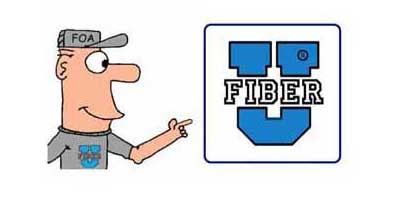Distributed
Antenna Systems (DAS)

Intended
For:
- Anyone
new to distributed antenna systems who wants to learn
how it works
- Designers
and installers involved
in projects with DAS cabling
- Managers
and supervisors involved in projects with DAS cabling
- May be used as additional preparation for the CFOS/W
Certification Exam
Objectives:
From this self-study program you should learn:
- How
distributed
antenna systems are designed to maximize
coverage
- How
cabling connects all elements of a distributed
antenna systems
- What
types of cabling (copper or fiber) are used in distributed
antenna systems
- Issues
in designing and installing distributed
antenna systems cabling.
- Prerequisites

When
you finish, you can take an online exam on this course to
qualify for a "Fiber U Certificate of Completion."
Introduction
Wireless
traffic is growing at a phenomenal rate. AT&T says
their cellular data traffic grew 50,000% (that's 500
times) between 2007 (the introduction of the iPhone)
and 2014. The landscape is covered with cellular
towers but the majority of cellular connections
(70-80% for both voice or data) originate inside
buildings, so wireless coverage inside buildings has
become more important. Cellular wireless signals often
cannot penetrate walls and even windows in large
buildings, requiring low-power cellular antennas
placed inside buildings to provide reliable service.
There are several other reasons for cellular systems
inside buildings or structures. Sometimes the number
of users inside a building like a convention center or
sports facility exceeds the bandwidth of a single
cellular system. In many areas, local laws specify the
need for public safety radio signal coverage (fire,
police, emergency) inside every building that requires
indoor antenna coverage.
Auto or mass transit tunnels are also obvious
applications for cellular distributed antenna systems.
A distributed antenna system is a fairly straightforward
installation, similar to a LAN connected to the Internet
with one major exception - a DAS may be shared by all
cellular service providers rather than be limited to one
user or one ISP. DAS for most facilities will use fiber
backhaul for the cellular connections because of the
bandwidth requirements. Small buildings may use an antenna
on the roof and coax cable for distribution inside the
facility, called a Passive DAS, but they are becoming
rare. DAS
cabling resembles structured cabling or OLAN cabling and
in fact can share the backbone cables if there are
sufficient fibers available. Since most DAS cabling is
singlemode, compatibility with the new generation GPON
OLAN which uses singlemode fiber is easiest.
DAS digital electronics are usually from one of two
standard system types set up by manufacturers for
compatibility. Cabling has no standard although TIA is
working on such a document, but it may take years to be
finished and does not seem to cover the typical digital
system architectures. Manufacturers of the equipment or
service providers generally dictate the cabling
architecture and specifications. So
as is the FOA’s procedure, we will summarize the options
and provide guidance on how the DAS is generally designed
and built and not spend our time on standards that will be
changing continuously! We do however try to keep our
references up to date.
In addition to the information on DAS design and cabling
options, we include links in this self-study program to
information relevant to installation.
Assignments
You
will be instructed to read the references or watch videos
and take the quiz (Test Your Knowledge) to complete the
"classroom" part of the course.
Get
Started
Watch
The Video
FOA
YouTube Video Lecture 40,
Distributed Antenna Systems
Read
The Online FOA Reference
FOA
Reference Guide, Fiber For Wireless
FOA
Reference Guide,
Distributed Antenna Systems
Test
Your Knowledge - DAS
Cabling Quiz

When
you finish the assignments and case study, you can take an
online exam on this course to qualify for a "Fiber U
Certificate of Completion." The exam cost is $20US.
Go
here to take the Fiber U DAS Certificate of Completion
exam. Here
are detail directions if this is your first time
taking a Fiber
U Certificate of Completion exam.
This information is
provided by The Fiber Optic Association, Inc. as a
benefit to those interested in teaching, designing,
manufacturing, selling, installing or using fiber optic
communications systems or networks. It is intended to be
used as an overview and/or basic guidelines and in no
way should be considered to be complete or
comprehensive. These guidelines are strictly the opinion
of the FOA and the reader is expected to use them as a
basis for learning, as a reference and for creating
their own documentation, project specifications, etc.
Those working with fiber optics in the classroom,
laboratory or field should follow all safety rules
carefully. The FOA assumes no liability for the use of
any of this material.
|
